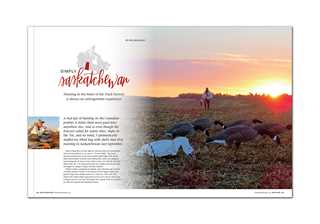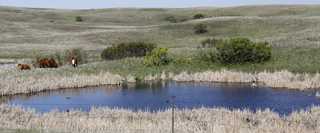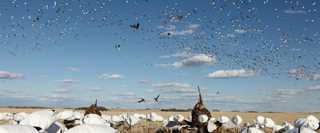Simply Saskatchewan
Hunting in the heart of the Duck Factory is always an unforgettable experience
Hunting in the heart of the Duck Factory is always an unforgettable experience

By Phil Bourjaily
A bad day of hunting on the Canadian prairies is better than most good days anywhere else. And so even though the forecast called for sunny skies, highs in the 70s, and no wind, I optimistically stuffed my blind bag with shells that first morning in Saskatchewan last September.
After a long drive in the dark we met up with our head guide, who was introduced to us only as "Uncle Wally." His hunting rig consisted of an old horse trailer piled high with shells, black homemade wooden duck silhouettes, and a few flappers and windsocks. It wasn't state of the art by any stretch, but that didn't faze me. I've had great hunts in Canada over decoys that belonged in antiques shops and flea markets.
Wally's trailer contained no blinds, only shovels and a bunch of white smocks. While we set decoys in the big pea field, our guides dug seven shallow holes in a wide arc. The crew left a shelf a few inches below ground level for us to sit on, then dug a deeper end for our feet. We pulled the smocks over us to blend in with the spread and hunkered down.

Warm temperatures and dead calm is a recipe for waterfowl hunting frustration, especially when snow geese are the main ingredient. But this was Canada, where even on tough days you still wind up with a nice bag. When the morning flight ended we had snows, small Canadas, cacklers, mallards, and the trophies of the trip-a pair of beautifully barred specklebellies shot by our host, Sure-Shot Game Calls owner Charlie Holder. Both geese wore shiny, sharp-edged bands that were most likely placed on them during the summer in the Arctic.
Saskatchewan, Canada's central prairie province, is among North America's most important waterfowl breeding areas. In wet years the amount of water in this province boggles the mind. Flying into Saskatoon from Winnipeg the day before our hunt, I'd been treated to a view of potholes beyond counting.
My brief visit gave me the merest snapshot of the state of Saskatchewan waterfowl habitat. To get the bigger picture, I contacted DU Canada biologist Dr. Scott Stephens, a fellow Iowan who escaped to this duck hunting mecca several years ago. "You can survey the landscape and still see a lot of great habitat," he says. "There are challenges, but as long as we can keep what we have, we'll have the capacity to produce a lot of ducks."
DU Canada protects wetlands mainly through two cost-effective methods-easements and a revolving lands strategy. Perpetual easements, which protect wetlands and associated grasslands, are a bargain. An easement costs about a third of the going price of an acre of land. In Saskatchewan that means it takes just $300 to secure an acre of prime habitat. Through its Revolving Land Program, DU Canada buys farmland, restores the wetlands and nesting habitat, places perpetual easements on the land, and puts it back on the market. After the sale, the capital is returned to the program's fund for future habitat acquisitions.
Each Canadian province makes its own environmental regulations with respect to wetlands, and Saskatchewan is no exception. According to Stephens, heavy flooding in 2011 and 2014 helped change thinking in that province, making DU Canada's job easier. "There are areas in Saskatchewan where we have seen large-scale clearing and draining these past few years, especially around Yorkton in eastern Saskatchewan. But the floods made people understand what happens when you drain wetlands," he says.
The disastrous floods occurred shortly after a widely publicized study of the flood-control benefits of wetlands was released by University of Saskatchewan hydrology professor John Pomeroy. "The ducks and biodiversity arguments don't play as well with the public as does the need for water quality and flood control. That's really carried the day for us," Stephens adds. "The conversation about wetland regulations has changed substantially since I arrived in Canada five years ago."
Hunting the prairies is like being in a weird, wonderful time warp that seems to transport you to an earlier era. Birds are naive. In fact, many are young of the year and haven't seen much hunting pressure. Land access is often readily granted by farmers. And waterfowling opportunities are everywhere.

Photo Michael Furtman
"Saskatchewan is really paradise for the freelance hunter," Stephens says. "DU Canada owns 170,000 acres open to hunting, and you can find the locations of these areas by visiting our regional offices or via our website at waterfowling.com. Then all you have to do is buy a rural municipality map that shows landholdings, get a local phone book to help you track down landowners, and start scouting. It's that simple. In the time I've been here I haven't been refused permission to hunt even once."
Most visiting hunters bring gear for hunting in fields and over water. Although the focus tends to be on grainfields, pothole hunting is also popular. Stephens spends a lot of time hunting over water because, as he puts it, "I like my ducks to go "splash.'" The allure of so many productive potholes can also be hard to resist.
Stephens looks for day roosts, or "sipping ponds," as local hunters sometimes call them. "These aren't regular roosting ponds, but places where ducks go to drink and loaf during the day," Stephens says. "If you have a good field hunt in the morning and you're done by 9 or so, get out and follow the ducks when they leave the field. You can do the same in the early afternoon before the evening feed and see where they spend the day."
Having been in on a few sipping pond hunts during past trips to Canada, I can vouch for their excellence. They can be among the best-and easiest-duck hunts of your life.
The afternoon following our becalmed snow goose hunt, Uncle Wally led us to another pea field. This time we had some wind to help us. From the start we were covered with Canadas, but there was a catch: dark goose hunting ends at noon in Saskatchewan. We could only enjoy the show and wait for ducks and light geese as bunch after bunch of Canadas worked the decoys.

Photo Dean Davenport
To no one's surprise, the light geese were finicky, though a few eventually strayed too close to our spread. I already liked the freedom of movement my personal pit blind afforded me, but I learned to love it when one Ross's goose flew straight overhead. I missed with my first shot, leaned back in the pit, then fired and missed again. On my third shot I bent backward to a point where I was almost parallel to the ground and folded the bird. That's a shot you can't make from a layout blind. There were plenty of ducks in the air, too. Bunches of 20 and 30 worked right into our faces and we called the shots at 15 yards.
My short stay in Saskatchewan included one last hunt the next morning. It was another warm, calm day, and those of us who had to catch early flights out chose to hunt a "backup" field that was conveniently close to camp but not normally swarming with waterfowl. Half the hunters in our group hid in a traditional Canadian willow blind and three others chose to lay out in the stubble in camo. I went old-school and hunted with a goose shell on my chest.
I'd like to say the hunting was spectacular, but it wasn't. We shot some ducks, bagged a few more honkers-and that was it. Still, a day and a half of "slow" shooting in Canada easily filled the soft-sided Yeti cooler our hosts generously gave us for the trip home. As one of the guides drove me to the airport, I was already looking forward to my next trip to Saskatchewan, when I would have more time to explore the province's incredible waterfowl hunting opportunities.
Ducks Unlimited uses cookies to enhance your browsing experience, optimize site functionality, analyze traffic, and deliver personalized advertising through third parties. By continuing to use this site, you agree to our use of cookies. View Privacy Policy